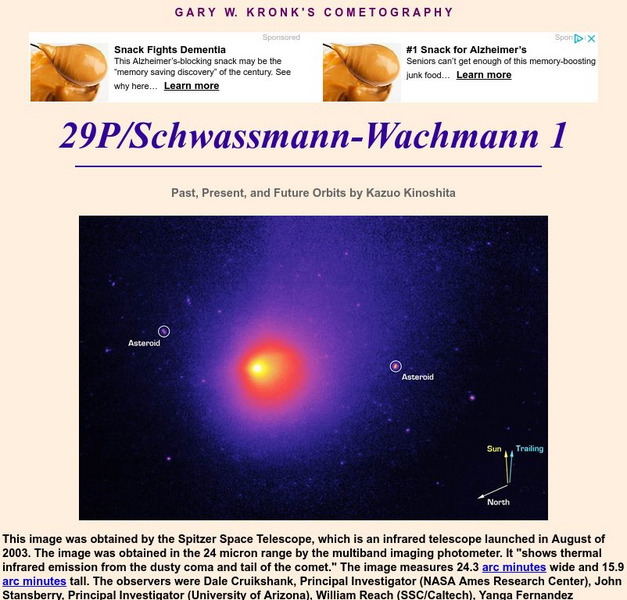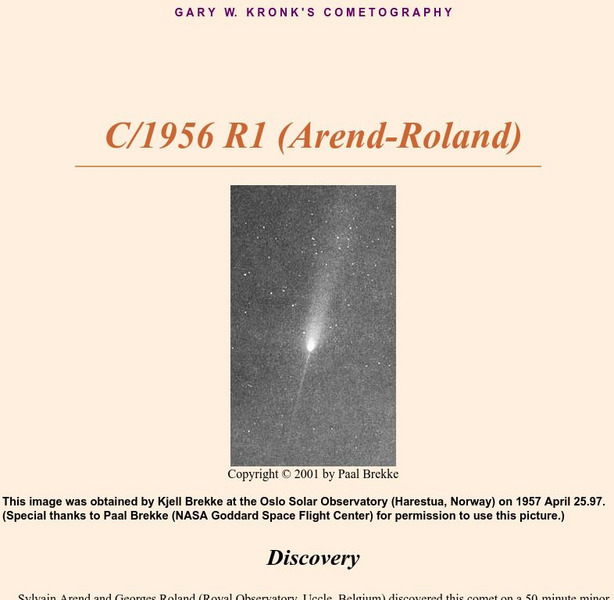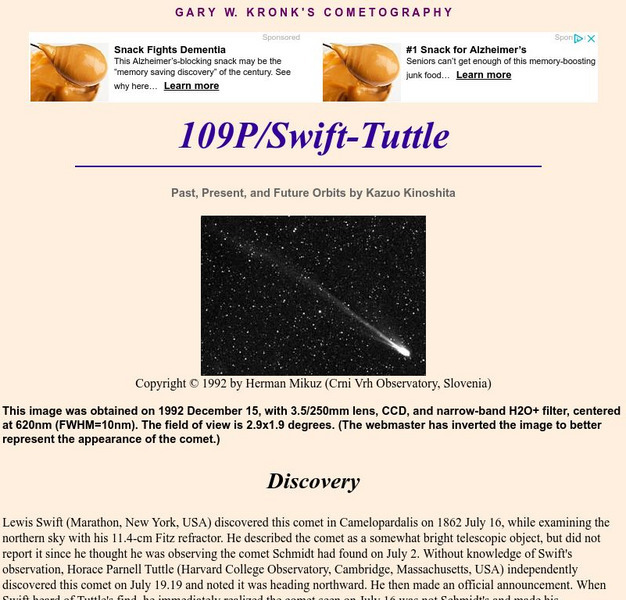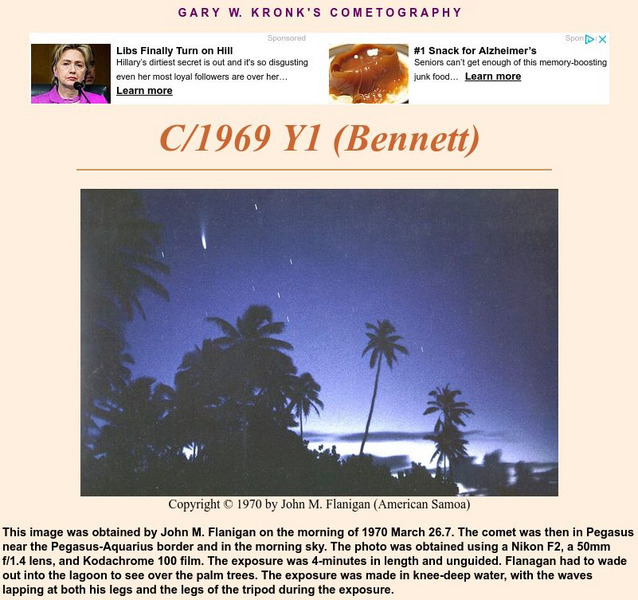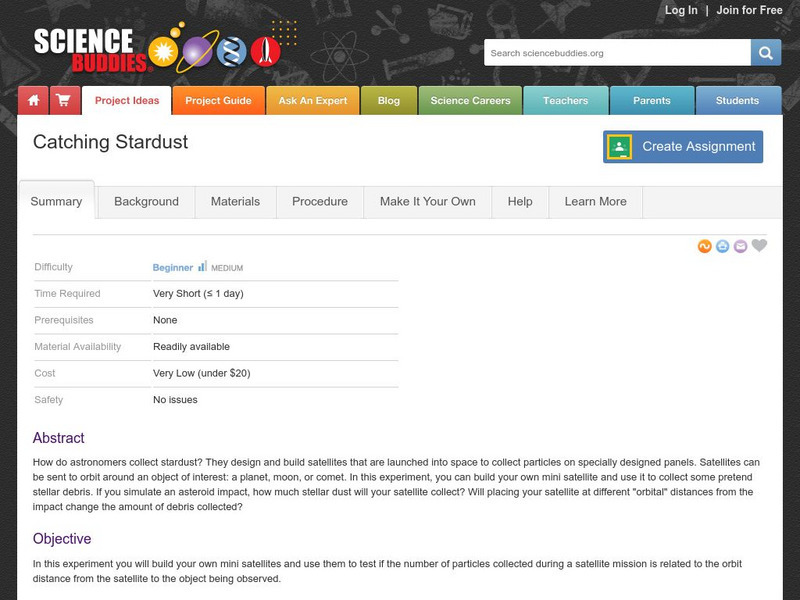PBS
Pbs Learning Media: All Planet Sizes
This illustration from the Lunar and Planetary Laboratory shows the approximate sizes of the planets relative to each other. Note that the planets are not shown at appropriate distances from the Sun.
Other
Cometography.com: C/1996 B2 (Hyakutake)
This site provides a detailed overview of the comet C/1996 B2 (Hyakutake). Content includes discovery, observational, and orbit information, as well as several images.
Other
Cometography.com: 29 P/schwassmann Wachmann 1
This site provides a detailed overview of the comet 29P/Schwassmann-Wachmann 1. Content includes discovery information, images, and historical highlights.
Other
Cometography.com: C/1956 R1 (Arend Roland)
This site provides a detailed overview of the comet C/1956 R1 (Arend-Roland). Content includes discovery information, orbit, images, and historical highlights.
Other
Cometography.com: 109 P/swift Tuttle
This site provides a detailed overview of the comet 109P/Swift-Tuttle. Content includes discovery information, images, and historical highlights.
Other
Cometography.com: C/1969 Y1 (Bennett)
This site provides a detailed overview of the comet C/1969 Y1 (Bennett). Content includes discovery information, images, and historical highlights.
Other
Cometography.com: C/2001 A2 (Linear)
This site provides a wealth of information regarding the C/2002 A2 (Linear) comet, including historical and discovery information.
Other
Cometography.com: C/2000 Wmi (Linear)
This site provides a detailed overview of the comet C/2000 WMI (Linear). Content includes discovery information, images, and historical highlights.
NASA
Nasa: Launch a Rocket From a Spinning Planet
This site from the National Aeronautics and Space Administration provides a fun project on rockets. "Nothing in space stands still. Everything either orbits around something else, or moves toward or away from something else. So how do...
Curated OER
Earth Orbits the Sun
This site from the National Aeronautics and Space Administration provides a fun project on rockets. "Nothing in space stands still. Everything either orbits around something else, or moves toward or away from something else. So how do...
Curated OER
Rocket Launched in Same Direction as Earth Orbit and Rotation
This site from the National Aeronautics and Space Administration provides a fun project on rockets. "Nothing in space stands still. Everything either orbits around something else, or moves toward or away from something else. So how do...
Enchanted Learning
Enchanted Learning: Zoom Astronomy
Where is our Solar System? How far away is the sun? What makes up the sun? Find out all you want to know about our solar system. This is a comprehensive on-line site about space and astronomy. Check out all of the excitement!
Science Buddies
Science Buddies: Catching Stardust
How do astronomers collect stardust? They design and build satellites that are launched into space to collect particles on specially designed panels. Satellites can be sent to orbit around an object of interest: a planet, moon, or comet....
Curated OER
H. Mikuz Images of C/1996 B2 Exposed on 1996 April 6
This site provides a detailed overview of the comet C/1996 B2 (Hyakutake). Content includes discovery, observational, and orbit information, as well as several images.
Curated OER
Cometography.com: C/1996 B2 (Hyakutake)
This site provides a detailed overview of the comet C/1996 B2 (Hyakutake). Content includes discovery, observational, and orbit information, as well as several images.
Curated OER
Cometography.com: C/1996 B2 (Hyakutake)
This site provides a detailed overview of the comet C/1996 B2 (Hyakutake). Content includes discovery, observational, and orbit information, as well as several images.
Massachusetts Institute of Technology
Mit: Open Course Ware: Earth, Atmospheric and Planetary Sciences: Solar System
A university-level course that looks at the structure of the solar system, the sun, the planets, and other bodies in space. Includes course readings, assignments, and study notes.
NASA
Nasa Space Science Data Archive: Galileo Project Information
This is the homepage of all of the archived information about and from the Galileo Mission. Included is data from the flybys of Venus, Earth, Moon, and Asteroids Gaspra and Ida, as well as the current data from Jupiter and its moons. See...
Curated OER
G. Rhemann Image of C/1995 O1 (Hale Bopp) Exposed on 1997 March 27
This site provides a detailed overview of the comet C/1995 01 (Hale-Bopp), the great comet of 1997. Content includes discovery, and observational and orbit information, as well as several images.
Curated OER
Crni Vhr Observatory Images of C/1995 O1 (Hale Bopp) March and April of 1997
This site provides a detailed overview of the comet C/1995 01 (Hale-Bopp), the great comet of 1997. Content includes discovery, and observational and orbit information, as well as several images.
National Earth Science Teachers Association
Windows to the Universe: Our Solar System
Our solar system is filled with a wide assortment of celestial bodies - the Sun itself, our eight planets, dwarf planets, and asteroids - and on Earth, life itself! The inner solar system is occasionally visited by comets that loop in...
Wonderville Media
Wonderville: Planets
There are eight planets in orbit around our Sun. These planets form our solar system. The eight planets are Mercury, Venus, Earth, Mars, Jupiter, Saturn, Uranus, and Neptune. There are also rocks, moons, comets, and other objects going...




